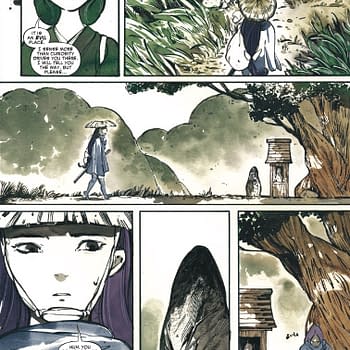Posted in: Comics, Recent Updates | Tagged: battleworld, boom studios, Comics, entertainment, marvel, runaways, the fiction, thors
Thor's Comic Review Column – The Fiction #1, Prez #1, Ghostbusters #1, Robin: Son Of Batman #1, Battleworld: Squadron Sinister #1, Runaways #1, Old Man Logan #2
This Week's Reviews:
The Fiction #1
Prez #1
Ghostbusters: Get Real #1
Robin: Son Of Batman #1
Battleworld: Thors #1
Battleworld: Squadron Sinister #1
Battleworld: Runaways #1
Battleworld: Old Man Logan #2
The Fiction #1 (Boom!, $3.99)
By Cat Taylor

As a set-up for the rest of the series, this isn't bad but it's not the most original idea ever. There is some promise showing here but this is only the first issue. Of course, the problem with the first issue of a brand new comic series is that it pretty much has to be a set-up for the rest of the series, but it needs to be entertaining enough in it's own right to hook new readers and keep them coming back. On that front, I can't say that I'm completely hooked. I can't really find anything to complain about, and the writer, Curt Pires, seems to have solid ideas and a good command of the narrative but this issue just lacks that "wow" factor that makes it a "must read" for me. One thing that would have helped me take more interest would have been stronger character development. Other than the fact that the characters are a group of friends with the kind of racial diversity that you usually only find in such proportions in fictional stories, I really didn't learn much about them. There are some superficial traits exhibited, such as Max being portrayed as self-centered and Kassie being a conspiracy-theory blogger, but that's about all I learned. Now, if you find yourself invested in these characters, then there are a few mysteries that you may want solved. Such as, "Who or what is that golden wooden looking guy with the flower and what is he doing?" or "Why did these people never go back to the world of the Fiction when they were younger to try and find their friend, Tsang?" I'm confident that these questions and more will be answered for those of you who are captivated by this issue.
What may lure a lot of people into giving this comic more than a walk-by at the Android's Dungeon is the attractive art by David Rubin and the bright colors from veteran colorist, Michael Garland. The cover jumped out at me in the way that a lot of the new Image books do. It's a look that's becoming more common among independent titles, but is still different enough at this point to stand out. While the cover alone will probably get your attention, I also found that the interior panels offer an interesting dichotomy with the serious tone of the story. Rubin's work is a lot more cartoony than one would expect. It's sort of a mix between the styles of Michael Allred, manga, and the art in Archie comics. Regardless, it's a style that you would expect to be used in a more humor-filled and light-hearted comic. Some people may find the contradicting styles annoying or distracting but I didn't. I think Rubin is talented enough to make his art work with any kind of story, and the addition of a modern-era colorist like Garland doesn't hurt either.
At any rate, this is a good creative team with styles that complement one another. It's just too bad that the first issue kind of flew by and didn't leave me with a sense of urgency to find out what will happen next. All I can say for certain is that I've been reading a lot of comics from the '70s and '80s lately, and a big difference I've noticed is that they crammed a whole lot more adventure into a single issue back then than modern comics give us in four. Sure, there were more pages in the older comics, but more importantly is that there was more story per page. Most comics in the modern-age have larger panels and the end result is less "meat". In a case like the Fiction, where the team is trying to attract new readers to characters that they've never met before, a first issue is critical. If readers don't get a lot out of issue one, they aren't as likely to come back for issue two and beyond. There is potential for a great tale to come out of this, but the Fiction is only a four-issue mini-series and a quarter of it is already gone.
Cat Taylor has been reading comics since the 1970s. Some of his favorite writers are Alan Moore, Neil Gaiman, Peter Bagge, and Kurt Busiek. Prior to writing about comics, Taylor performed in punk rock bands. He's still mad at the world but he gets over it a lot quicker than he used to. You can e-mail Cat at cizattaylor@hotmail.com.
Prez #1 (DC Comics, $2.99)
By Devon Sanders (@devonsanders)
The future is here and we are living it in the wonderful satire that is Prez #1 by writer Mark Russell and artist Ben Caldwell.
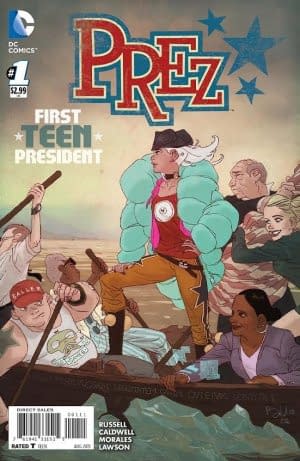
Want to win an election? How bad to you want it? Are you willing to go to Ohio and have your ass paddled by its biggest YouTube sensation? Yes? Then you're on your way. Enter into all of this, Beth Ross, the internet viral sensation better known to the world as "Corn Dog Girl" because she managed to get her ponytail stuck in a corndog fryer. The reason why? In a bit of brilliance, writer Mark Russell has created SickStarter, a place where people with little to no health insurance crowdfund in the hope that people with money find some sympathy in your suffering. Beth's dad is near death and after she can't bring herself to cripple her body for monetary gain on television, she finds herself and her dad without much of a future. Enter the political machine where people can't be bothered to stand in line to vote anymore so now, you can do so on social media. The politicians don't or won't connect with the people anymore and the only thing that holds anyone's attention is the ability to go viral. She may not know it yet but America's best bet may just be a young girl with heart and so much to say after she got her ponytail stuck in a fryer.
Prez #1 is a book with so much to say. Russell creates a satire that truly speaks to our times and leaves me questioning where this is all could be headed. In Beth Ross, he gives us a protagonist we want to see win simply because the bar has been set so low in this future that I can't wait to see her raise it, even if just an inch.
Artist Ben Caldwell is the perfect choice for this comic. Caldwell creates a reality constantly in flux. There's a hyperactivity here that simply suits the story's needs. Caldwell's use of facial expression and body language is just a joy. I simply love seeing how his characters interact. It's considered and adds to the story overall.
Prez #1, with its sly delivery and brilliant use of satire, is one of the bravest and most thoughtful books on the market today.
Devon Sanders doesn't know why you'd want to be half man/half amazing when you could be all man/all amazing. Find him on Twitter at @devonsanders.
Ghostbusters: Get Real #1 (IDW Publishing)
By Bart Bishop
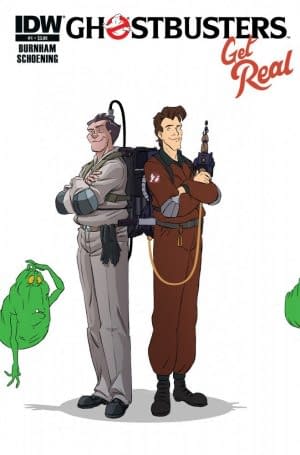
The story is pretty simple. The Real Ghostbusters (it's silly to have to refer to them as such, considering the descriptor was only added to defer confusion with the monster mash show Filmation's Ghostbusters, but necessary) have been experiencing "a massive uptick in spectral energy" recently along the lines of Gozer's attack on New York City. After helping a friendly witch, they clash with the god Proteus, the son of Poseidon, who has taken the form of a giant statue in Rockefeller Plaza. When the witch tries to help them with a protection spell, they end up being shunted sideways into an alternate reality, that being the universe of IDW's Ghostbusters. After the expected contrast/compare shenanigans, with the only major contrast being Slimer is a threat on the other side of the pond, the doppelgangers team up to get the cartoon versions home (with a leftover portal from the previous adventure with the Ninja Turtles, nice touch), but not before the call of adventure promises double trouble action next issue.
Burnham has two daunting tasks with this issue and series: he has to recapture the voice and feel of a beloved and long-gone 1980s cartoon series that itself was attempting to translate a fairly adult movie into product fit for children, and he has to make the two teams distinct against each other. Although like I stated above this is perhaps a fruitless gesture, he does the best anyone can do in this situation. The Real Ghostbusters are all distinct in personality and color code, and meeting their cinematic counterparts makes for a nice cracked mirror moment, as they realize this world is a little grungier than their own. The 1984 Ghostbusters, as I'll think of them, are also succinctly brought to life, with Egon's curiosity and lack of social skills bouncing well off of his animated self's more well-adjusted, if still thoroughly analytical, personality. The villain Proteus is also promising and squarely in the vein of Gozer, considering she (he? it?) was an ancient god, and it's just different enough to stand out against yet more ghosts.
Schoening has, meanwhile, nailed the look of both perfectly. The opening with the Real GB characters mimics the series to a T, even having a slightly faded color scheme reminiscent of catching reruns that haven't been remastered. There's a sense of innocence and naiveté to the early scenes, it's just funny that when these four arrive in movie New York, it should still be the 1980s, right? I'm not sure how the sliding timeline works in the IDW world, but it certainly would be a lot more startling if the cartoon characters of the past arrived in a contemporary setting with cell phones and Kardashians and such. Regardless, Schoening also captures the movie versions, as these variations are most definitely Murray, Akroyd, Ramis and Hudson, which is nice considering the real GB are anything but. As such his style is breezy and adaptable, although I hope later issues make more of the "realness" of IDW's New York, as these aren't just different versions, they're from a completely different medium.
With the new movie, and possibly shared cinematic universe, on the cusp of springing to life, it's nice to indulge not one but two classic iterations of favorite characters. Both are given justice, and although I expected more of a Marvel Comics-esque butting heads, sometimes it's nice to see characters behave professionally. After all, they've seen weirder, right?
Editor and teacher by day, comic book enthusiast by night, Bart has a background in journalism and is not afraid to use it. His first loves were movies and comic books, and although he grew up a Marvel Zombie he's been known to read another company or two. Married with a newborn daughter, he sure hopes this whole writing thing makes him independently wealthy someday. Bart can be reached at bart.bishop@cincinnatistate.edu and on Twitter @BartLBishop.
Robin: Son Of Batman #1 (DC Comics, $3.99)
By Devon Sanders (@devonsanders)

And man, does he deliver!
Half a world away, a boy barely five feet tall stands tall, ready to take down a nation to take back what's his: a giant Man-Bat he's affectionately named "Goliath." With a tooth-liberating right cross, Goliath's freedom is newly won. He'll be needed as Damian, with little deliberation, will set himself on a path that will either damn or free his newfound soul.
Meanwhile, on a dock in Gotham Harbor, an old threat thought ended comes back in a new and intriguing way.
Patrick Gleason, in his writing debut, simply takes this one home. Gleason's Damian is every bit the jerk he ever was under previous scribes Morrison and Tomasi but now, he somehow seems more vulnerable. In an amazingly well-paced dream sequence, we're let into Damian head and we see the mind of a boy who's himself died and watched his mother and father do so as well. It's heartbreaking to see that for all of his outward bravado, knows he's really just a little boy who's lost so much.
As far as Gleason's art duties go, he remains as stellar as ever. I've long counted him as one of comics' current best storytellers, combining innovative layouts with absolutely gorgeous figure work. Gleason's art is, at times, almost like jazz. Big things can be found in the little notes. A small glance a character gives to another; an entire page given to the opening of a door, it all goes to the story overall and I'm simply glad to be a witness.
Robin: Son Of Batman #1 is a great and wonderful beginning for Damian Wayne, in his mind and many others, the best of the Robins and to mine, the last of the great DC Universe creations.
Devon Sanders lost his smile and regained it on a ladder. At Twitter, wish him luck at @devonsanders.
Jeb D. Does More Battleworld:
Battleworld: Thors #1 (Marvel, $3.99)
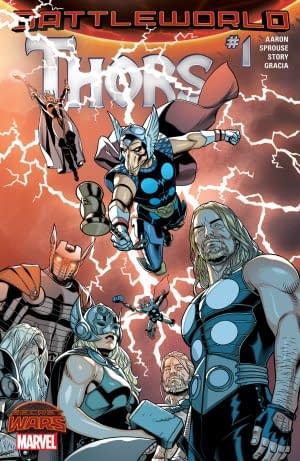
In a lot of ways, Thors is exactly what this kind of What-If event is all about: familiar characters deployed effectively into unfamiliar contexts. By now, the peculiar concept of "Thor" as a legacy character is sufficiently well established that Aaron has a substantial cast to work with, and his pairing of Ultimate Thor and Beta Ray Bill as detective partners investigating a serial killer flows nicely. The banter has the familiar snap of an Ed McBain or Richard Price, and there's even less backstory needed here than in most Battleworld books, as the reader is brought smoothly into the investigation with little to no foreknowledge needed.
But juxtaposed against Aaron's gripping Weirdworld from last week, Thors is perhaps a bit too smooth and comfortable. The tropes are familiar, as is the signposting: there's a character death that is telegraphed with a scene you've seen in dozens of crime movies, and for some reason, Aaron has decided to keep things almost strictly Asgardian, reducing the fun of the surprise cosplay we're getting in some of the other Battleworld titles: when I tell you that the roll call of characters here includes a crusty old station commander and a weasly informant, you could cast the thing yourself.
Artist Chris Sprouse, inker Karl Story, and colorist Marte Gracia straddle the panoply of Asgardian color and the dank grit of a murder investigation, the balance weighted towards the super. It's a fine-looking book; hopefully subsequent issues will take things in a somewhat more visually dynamic direction, to let Sprouse cut loose.
Thors is an entertaining and expertly crafted piece of genre fiction that is long on familiar tropes, short on surprises; sometimes, though, the predictability is part of the charm.
Battleworld: Squadron Sinister #1 (Marvel, $3.99)
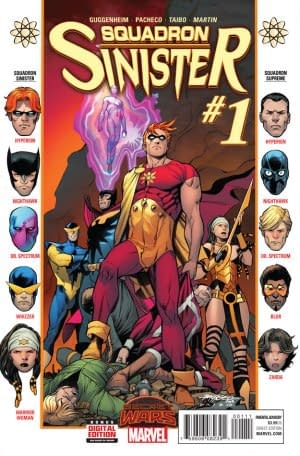
Squadron Sinister is one of the more overtly-Game of Thrones inspired series in Battleworld so far: naked lust for power is the story engine here, two-faced double-dealing the coin of the realm. Hyperion is the Baron who seeks dominion over neighboring fiefdoms, Nighthawk his scheming subordinate. Writer Marc Guggenheim seems to be having the most fun with the Whizzer, whose wise-ass nastiness nicely encapsulates the smug superiority of Hyperion and company. Mind, they're still very much under Doom's thumb, and when another of Doom's enforcers meets an untimely end, it begins to peel back the surface on the secret agendas that the various members of the team are pursuing.
Carlos Pacheco, with inks from Mariano Taibo, knows that this comic demands to go old-school, and every page is a superpowered delight, from the brutal beatdown that the Sinisters lay on the Straczynski/Frank version of the Squadron Supreme, to the massive destruction in its wake, to such little touches as the way Pacheco depicts Hyperion in poses we recognize from classic Superman comics, or the familiar trophies he places in the Squadron Citadel's display case; I also love the expression of sheer dementia on Hyperion's face as he destroys an outmatched foe.
There's still a lot of story to unpack in this miniseries; the one drawback at this point might be that our protagonists are such a pack of outright bastards that it may be hard to care much who comes out on top. Kind of like Game of Thrones, really, with no Tyrion or Arya to root for.
Battleworld: Runaways #1 (Marvel, $3.99)
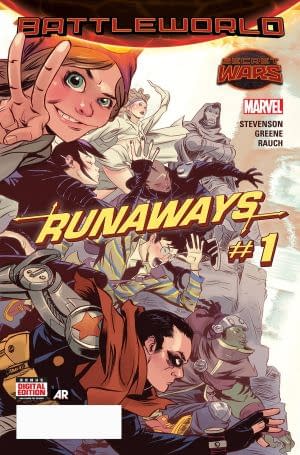
Runaways hasn't had an easy time of it since Vaughan left, though; considering how perfectly Vaughan defined the characters and their world, that's pretty surprising. Joss Whedon had fun taking them on a time-travel adventure, but subsequent series never seemed to catch fire, despite the efforts of capable writers like Terry Moore, Christopher Yost, and Kathryn Immonen. I presume this Battleworld series has the potential to serve as the launch of a new version of Runaways, to be aligned with properties like Silk and Spider-Gwen, aimed at an audience outside the superhero comics' traditional aging white male fanbase.
For Battleworld, writer Noelle (Lumberjanes) Stevenson and artist Sanford Greene bring us yet another new Runaways roster, some names and faces familiar, others swapped around a bit. These kids aren't the offspring of a team of super-villains, but instead students at the Victor Von Doom School for Gifted Youths. Naturally, they're high-spirited and bored (Amadeus Cho most of all), and their class-cutting antics lead to the kind of disruption of authority that does not go down well with Doom, or his daughter (whose identity is no surprise to Secret Wars readers, but can be left unspoiled for those who wish to read this series on its own). The book is heavy with teen-slangy conversation and snappy patter, and the rough scrappiness of Greene's art, with its vigorous exploration of different camera angles, helps to keep the eye engaged when the spawn-of-Whedon dialog starts to go on a bit.
As much as any of the Battleworld books, Runaways relies for its appeal on defining its characters through well-crafted dialogue, rather than plot, since to this point, there's not some huge crisis on the horizon to draw the reader in (though we're pretty sure that Doom won't be satisfied with just grounding these kids). But if you find Stevenson's portrayal of these characters appealing enough, you'll be back for issue #2.
Battleworld: Old Man Logan #2 (Marvel, $3.99)
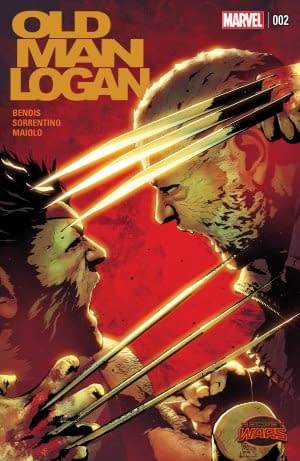
I assume that the decision to kill off modern-day Wolverine and ultimately replace him with this alternate-universe future version has something to do with the mishegoss over the Fox movie rights, but it will be pretty disappointing if the endgame turns out to be just another version of the X-Men, with the only difference being that we get a beat-up worn-down model of the ol' Canucklehead. That, though, is certainly the impression left by this issue.
Things actually get off to a strong start, as the first half of the book gives us Logan's encounters with beasts and gods on the other side of the Shield. Artist Andrea Sorrentino and colorist Marcelo Maiolo continue to make this an absolutely amazing looking, vigorous and kinetic comic: the nearly wordless first section, as Logan begins his infiltration of Doom's kingdom, is masterly visual storytelling (sort of an aside: though we all give Brian Bendis shit for his overuse of mannered dialogue, I doubt it's a coincidence that his artists often shine in this kind of extended dialogue-free sequence; Bendis knows how to write action). In fact, their last-page introduction of the villain of the piece has the kind of awesome power that can almost make me rethink my weariness at the thought of yet another round with one of the X-Men's familiar foes.
Unfortunately, by the time that happens, much of the story's goodwill has been undercut by a talkfest between Logan and another iteration of his old teammates. Questions are raised regarding just what Logan can and can't trust about his memories (and what we've been shown, and told, both in this series and in Mark Millar and Steve McNiven's original), and one has the gloomy sense that yet another reset button is waiting to be hit, post-Secret Wars.
Old Man Logan continues to be highly recommended for its art, among the best I've seen in a Big 2 comic in quite some time. And I'm not completely ready to give up on the story yet. After all, it could be worse: at least the big bad introduced at the end isn't f*cking Arcade.
Jeb D. hopes your Father's Day was as nice as his.











